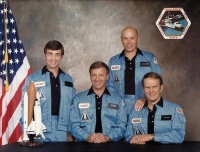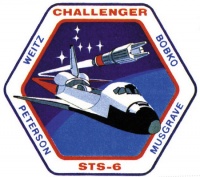STS-6
From The Space Library
 | |
| Organization | NASA-Office of Space Flight (United States) |
|---|---|
| Mission type | Earth Science,Human Crew |
| Launch date | April 4, 1983 |
| Launch vehicle | Space Shuttle |
| Launch site | Cape Canaveral, United States |
| COSPAR ID | 1983-026A |
| Inclination | 28.45 degrees |
| Experiments | Here |
| Alternate Names | 13968 |
| Additional Information | Here |
| Data Collection | Here |
| Payload Mass Up | 21277 kg |
| Payload Mass Down | 4284.09 kg |
| Orbiter | Challenger |
| Lift Off Mass | 2,039,661.36 kg |
| Orbiter Weight at Liftoff | 116,701.82 kg |
| Orbiter Weight at Landing | 86,513.64 kg |
| Landed | Concrete runway 22 at Edwards Air Force Base, Calif. |
| Orbits of Earth | 80 |
| Orbital Altitude | 155 nautical miles (178 statute miles) |
Contents |
[edit] Crew
- Commander: Paul Weitz
- Pilot: Karol Bobko
- Mission Specialist 1: Donald Peterson
- Mission Specialist 2: Story Musgrave
[edit] Mission
STS 6 was the second operational flight of the Space Transportation System. Astronauts Paul Weitz, Karol Bobko, Donald Peterson, and Story Musgrove were on board and deployed the first Tracking and Data Relay Satellite (TDRS) used to provide improved tracking and data acquisition services to spacecraft in low earth orbit. An EVA (extra- vehicular activity) was performed. The mission duration was 120 hours 23 minutes 42 seconds.
[edit] EVA
Extravehicular Activity (EVA) conducted by Story Musgrave and Donald Peterson, 3 hours and 54 minutes.
[edit] Payload
Deployment of Tracking and Data Relay Satellite (TDRS)-A with Inertial Upper Stage (lUS)-2; Continuous Flow Electrophoresis System (CFES); Monodisperse Latex Reactor (MLR); Night/Day Optical Survey of Lightning (NOSL) experiment; three getaway specials (GAS)
[edit] Books about the Space Shuttle Program
Buy This Book Click here |
Buy This Book here |
Buy This Book Click here |
Buy This Book Click here |





